Study on Adaptability of Test Methods for Workability of Fresh Self-Compacting SFRC
Abstract
:1. Introduction
2. Experimental Work
2.1. Raw Materials
2.2. Mix Proportion
2.3. Test Methods
3. Test Results and Discussion
3.1. Filling Ability
3.2. Passing Ability
3.3. Segregation Resistance
4. Conclusions
- (1)
- The filling ability of self-compacting SFRC can be determined by the slump-flow test and evaluated with the indices of slump-flow and flow time T500. The slump cone should be vertically lifted off to a height of 300 mm within 3 s at a constant speed.
- (2)
- The passing ability of self-compacting SFRC can be determined by the J-ring test and evaluated with an index of PA level. The rebar spacing of the J-ring should be adjusted to be two times the fiber length to get an equivalent evaluation to the passing ability of SCC.
- (3)
- The stability of self-compacting SFRC can be determined by the static segregation test of the coarse aggregate. When the dynamic segregation test is used, the dynamic segregation percent should be adjusted to be 35%. If the limit of 10% as specified in the China codes is adopted, it is hypercritical to self-compacting SFRC, even SCC, the evaluation of dynamic segregation resistance will be a contradiction to the evaluation of static segregation resistance.
- (4)
- The self-compacting SFRC prepared in this study has good workability with filling, passing, and stable abilities. The mix proportion of self-compacting SFRC was rationally designed by using the direct mix design method based on the packing test of the steel fiber-aggregates skeleton. However, much more test data should be accumulated to verify the suggested adjustments of details for the rational specifications.
Author Contributions
Funding
Institutional Review Board Statement
Informed Consent Statement
Data Availability Statement
Conflicts of Interest
References
- Ministry of Housing and Urban-Rural Development of the People’s Republic of China. Technical Specification for Application of Self-Compacting Concrete; JGJ/T 283-2012; China Architecture & Building Press: Beijing, China, 2012. [Google Scholar]
- BIBM; CEMBUREAU; EFCA; EFNARC; ERMCO. The European Guidelines for Self-Compacting Concrete Specification, Production and Use; UK. 2005. Available online: http://www.efca.info/download/european-guidelines-for-self-compacting-concrete-scc/ (accessed on 29 August 2021).
- China Association of Engineering Construction Standardization. Test Methods for Steel Fiber Reinforced Concrete; CECS 13:2009; China Planning Press: Beijing, China, 2010. [Google Scholar]
- Ding, X.X.; Li, C.Y.; Han, B.; Lu, Y.Z.; Zhao, S.B. Effects of different deformed steel-fibers on preparation and fundamental properties of self-compacting SFRC. Constr. Build. Mater. 2018, 168, 471–481. [Google Scholar] [CrossRef]
- Ding, X.X.; Li, C.Y.; Li, Y.Z.; Lu, Y.Z.; Song, C.; Zhao, S.B. Experimental and numerical study on stress-strain behavior of self-compacting SFRC under uniaxial compression. Constr. Build. Mater. 2018, 185, 30–38. [Google Scholar] [CrossRef]
- American Society of Testing Materials. Standard Test Method for Slump Flow of Self-Consolidating Concrete; ASTM C1611/C1611M-2014; American Society of Testing Materials: West Conshohocken, PA, USA, 2014. [Google Scholar]
- American Society of Testing Materials. Standard Test Method for Passing Ability of Self-Consolidating Concrete by J-Ring; ASTM C1621/c1621M-17; ASTM: West Conshohocken, PA, USA, 2014. [Google Scholar]
- ASTM International. Standard Test Method for Static Segregation of Self-Consolidating Concrete Using Column Technique; ASTM C1610/C1610M-14; ASTM: West Conshohocken, PA, USA, 2014. [Google Scholar]
- Ozyurt, N.; Mason, T.O.; Shah, S.P. Correlation of fiber dispersion, rheology and mechanical performance of FRCs. Cem. Concr. Compos. 2007, 29, 70–79. [Google Scholar] [CrossRef]
- Grunewald, S.; Walraven, J.C. Parameter-study on the influence of steel fibers and coarse aggregate content on the fresh properties of self-compacting concrete. Cem. Concr. Res. 2001, 31, 1793–1798. [Google Scholar] [CrossRef]
- Zhao, M.L.; Li, J.; Law, D. Effects of flowability on SFRC fibre distribution and properties. Magaz. Concr. Res. 2017, 69, 1043–1054. [Google Scholar] [CrossRef]
- Cao, M.L.; Li, L. New models for predicting workability and toughness of hybrid fiber reinforced cement-based composites. Constr. Build. Mater. 2018, 176, 618–628. [Google Scholar] [CrossRef]
- Cao, M.L.; Li, L.; Shen, S. Influence of reinforcing index on rheology of fiber-reinforced mortar. ACI Mater. J. 2019, 116, 95–106. [Google Scholar] [CrossRef]
- Ponikiewski, T. The rheological properties of fresh steel fibre reinforced self-compacting concrete, Conference: Brittle matrix composites. In Proceedings of the Eighth International Symposium on Brittle Matrix Composites BMC8, Warsaw, Poland, 23–25 October 2006. [Google Scholar]
- Ponikiewski, T.; Katzer, J. Shaping Properties of Self Compacting Concrete by Different Steel Fibre. Key Eng. Mater. 2020, 832, 21–28. [Google Scholar] [CrossRef]
- Enfedaque, M.G.A.; Gálvez, J.C. The effect of fibres in the rheology of self-compacting concrete. Constr. Build. Mater. 2019, 219, 144–153. [Google Scholar]
- Ministry of Housing and Urban-Rural Development of the People’s Republic of China. Steel Fiber Reinforced Concrete; JG/T 472-2015; Ministry of Housing and Urban-Rural Development of the People’s Republic of China: Beijing, China, 2015.
- Ding, Y.N.; Li, S.; Zhang, Y.; Thomas, A. The investigation on the workability of fiber cocktail reinforce self-compacting high performance concrete. Constr. Build. Mater. 2008, 22, 1462–1470. [Google Scholar] [CrossRef] [Green Version]
- Standardization Administration of the People’s Republic of China. Common Portland Cement; GB175-2007; Standardization Administration of the People’s Republic of China: Beijing, China, 2007. [Google Scholar]
- Standardization Administration of the People’s Republic of China. Fly Ash Used for Cement and Concrete; GB/T 1596-2017; Standardization Administration of the People’s Republic of China: Beijing, China, 2017. [Google Scholar]
- Ministry of Housing and Urban-Rural Development of the People’s Republic of China. Technical Code for Application of Mineral Admixture; GB/T51003-2014; Ministry of Housing and Urban-Rural Development of the People’s Republic of China: Beijing, China, 2014.
- Standardization Administration of the People’s Republic of China. Sand for Construction; GB/T 14684-2011; Standardization Administration of the People’s Republic of China: Beijing, China, 2011. [Google Scholar]
- Standardization Administration of the People’s Republic of China. Pebble and Crushed Stone for Construction; GB/T 14685-2011; Standardization Administration of the People’s Republic of China: Beijing, China, 2011. [Google Scholar]
- Zhao, M.L.; Ding, X.X.; Li, J.; Law, D. Numerical analysis of mix proportion of self-compacting concrete compared to ordinary concrete. Key Eng. Mater. 2018, 789, 69–75. [Google Scholar] [CrossRef]
- Ding, X.X.; Zhao, M.L.; Zhou, S.Y.; Fu, Y.; Li, C.Y. Statistical analysis and preliminary study on the mix proportion design of self-compacting SFRC. Materials 2019, 12, 637. [Google Scholar] [CrossRef] [PubMed] [Green Version]
- Ding, X.X.; Zhao, M.L.; Li, J.; Shang, P.R.; Li, C.Y. Mix proportion design of self-compacting SFRC with manufactured sand based on the packing test of steel fiber-aggregates skeleton. Materials 2019, 12, 2833. [Google Scholar]
- Ferrara, L.; Bamonte, P.; Caverzan, A.; Musa, A.; Sanal, I. A comprehensive methodology to test the performance of Steel Fibre Reinforced Self-Compacting Concrete (SFR-SCC). Constr. Build. Mater. 2012, 37, 406–424. [Google Scholar] [CrossRef]
- Wang, X.; Taylor, P.; Wang, K.; Morcous, G. Effects of paste-to-voids volume ratio on performance of self-consolidating concrete mixtures. Mag. Concr. Res. 2015, 67, 1–15. [Google Scholar] [CrossRef]
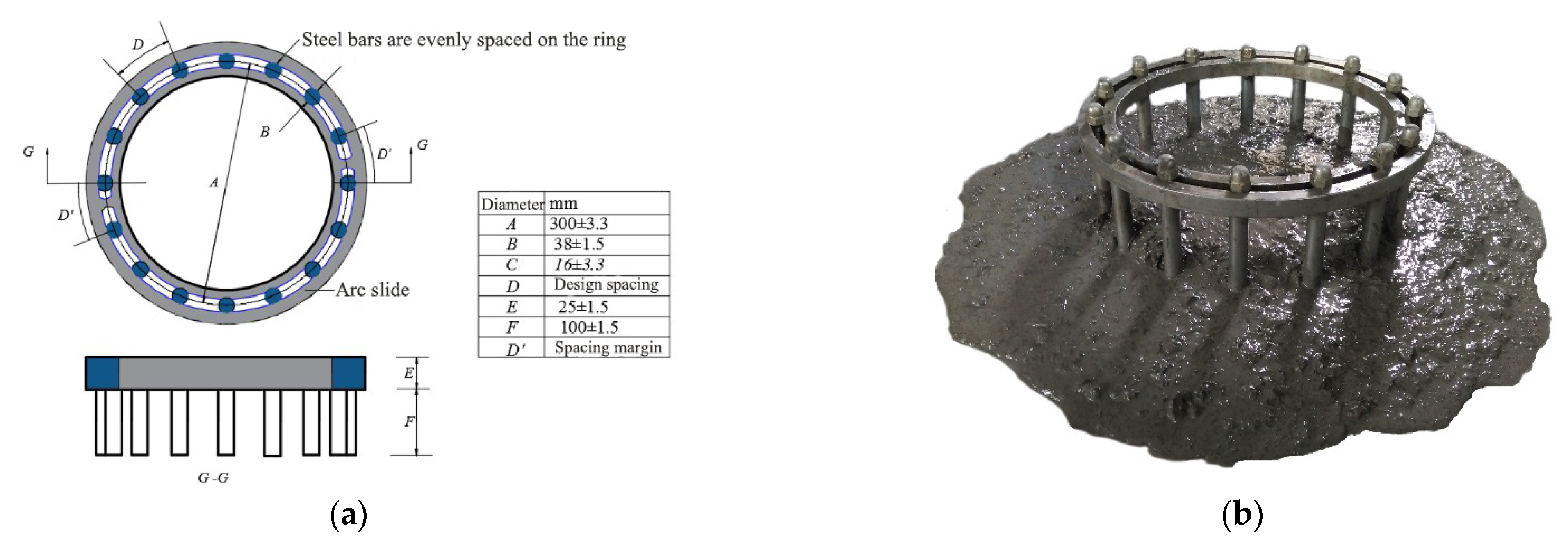
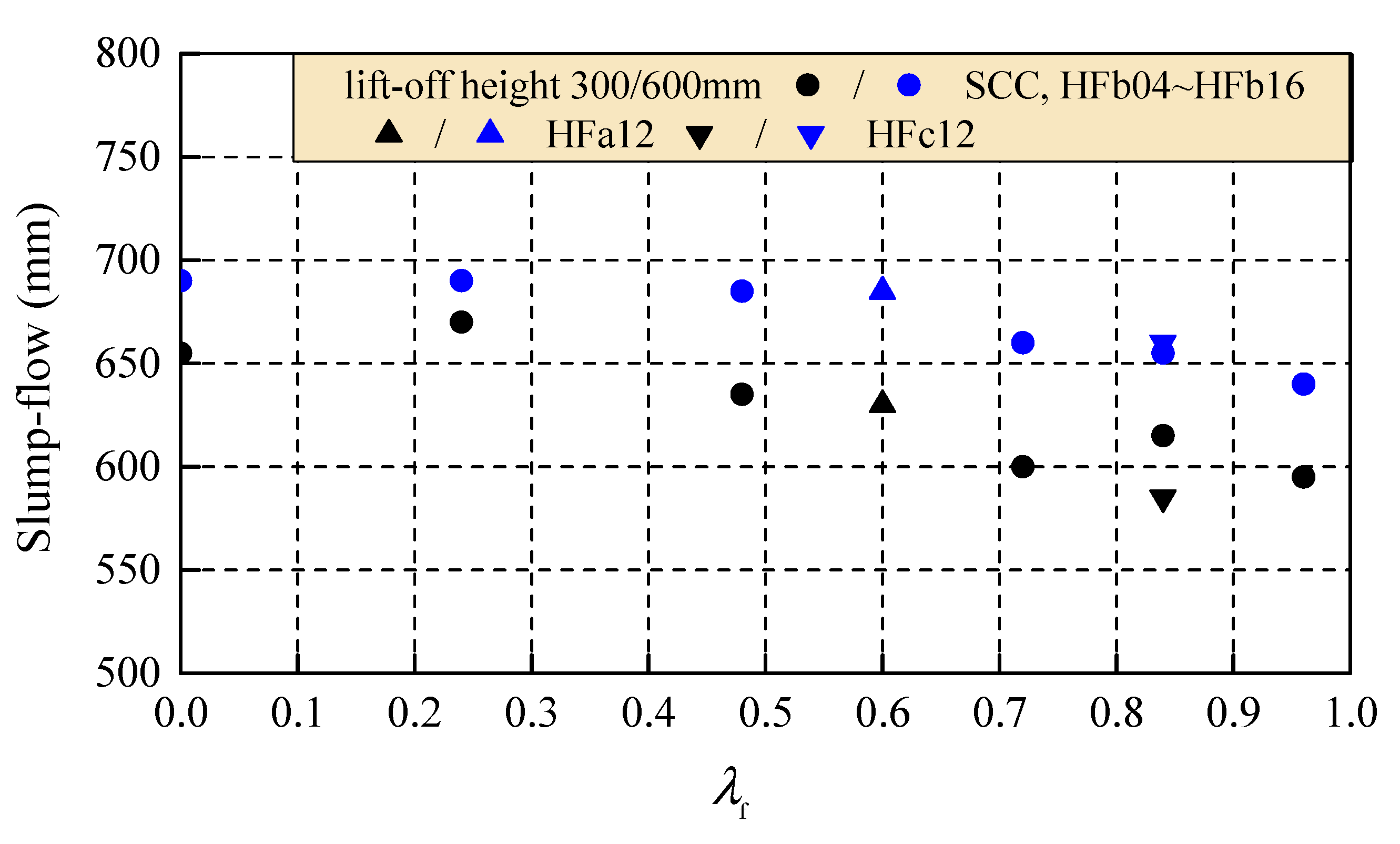


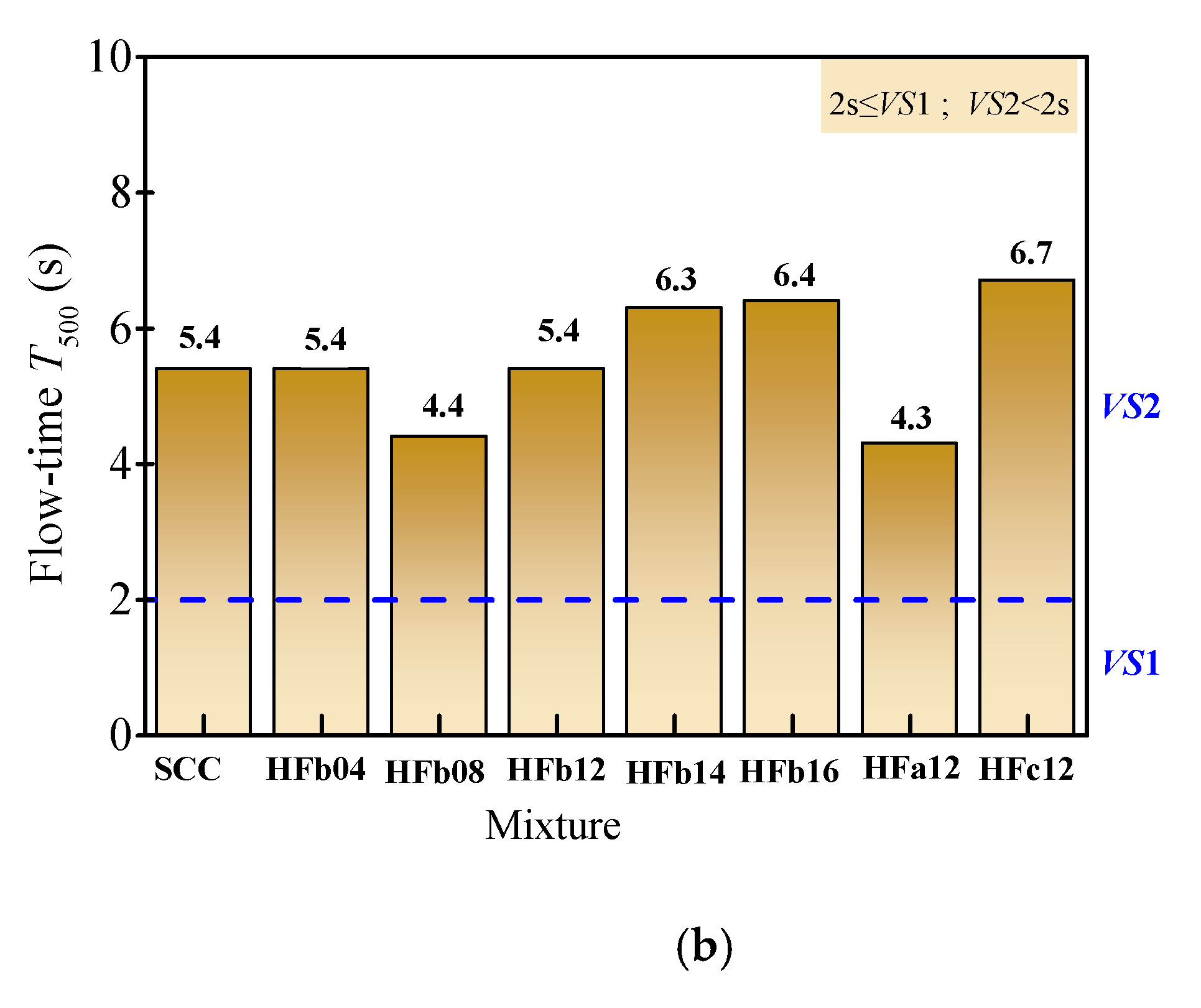
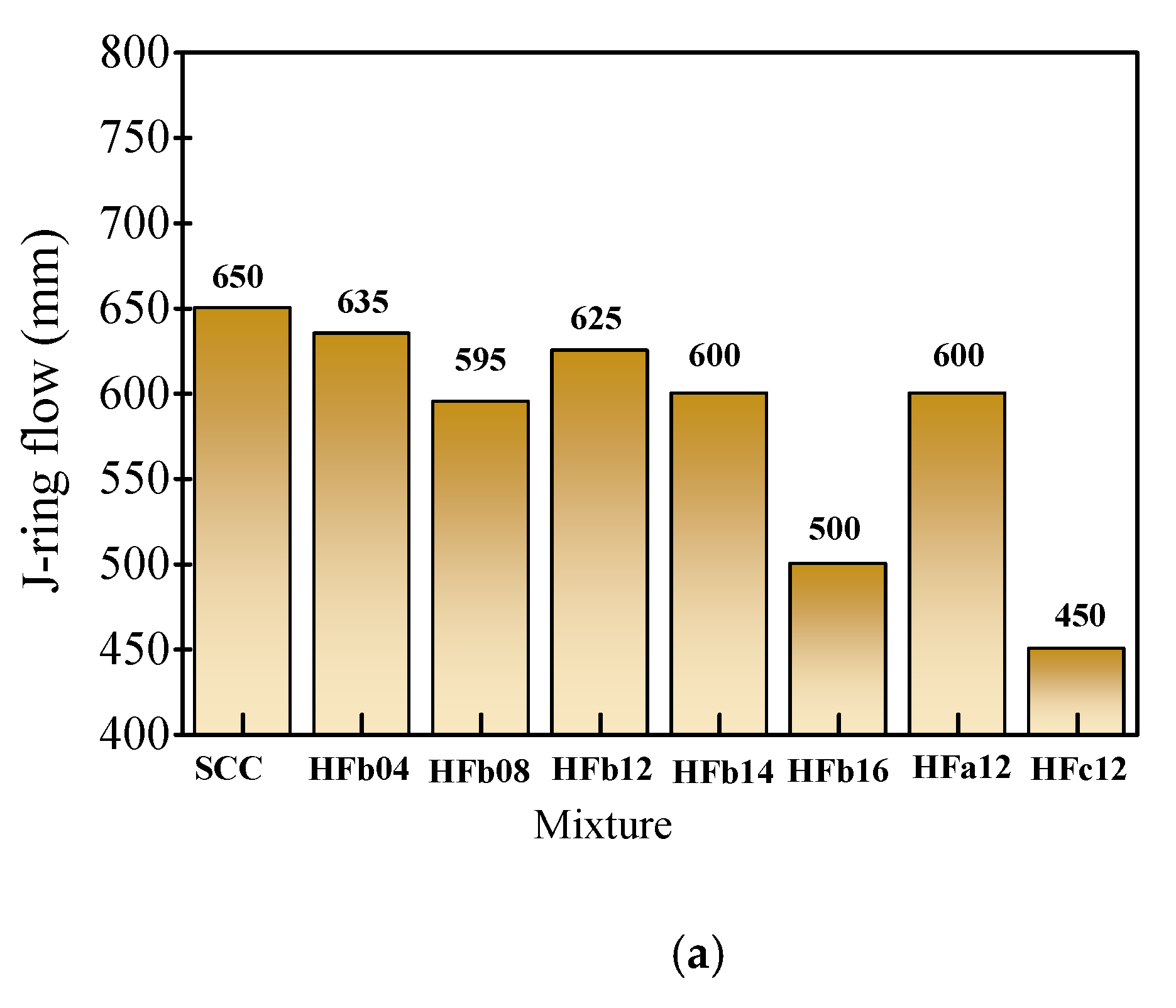
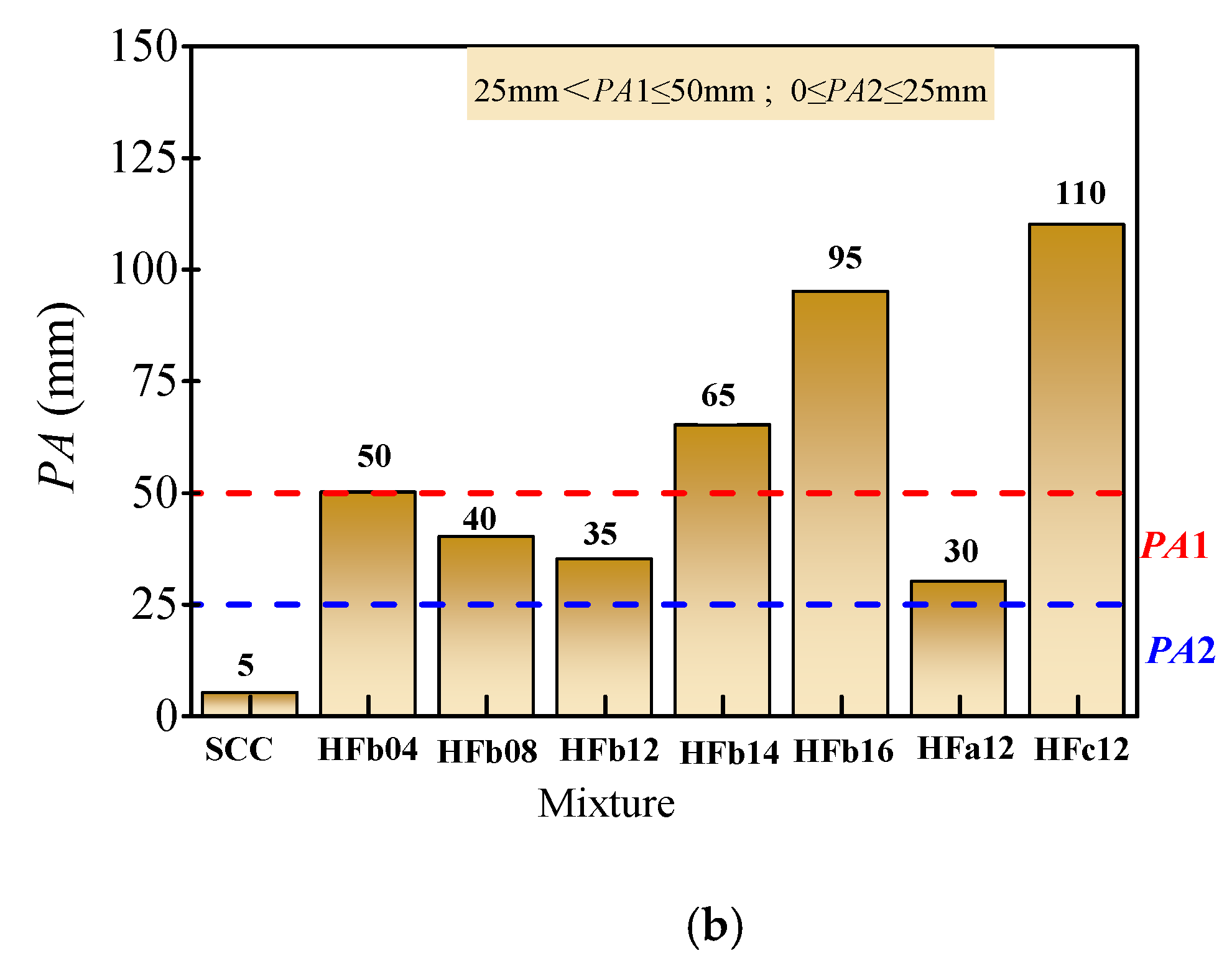
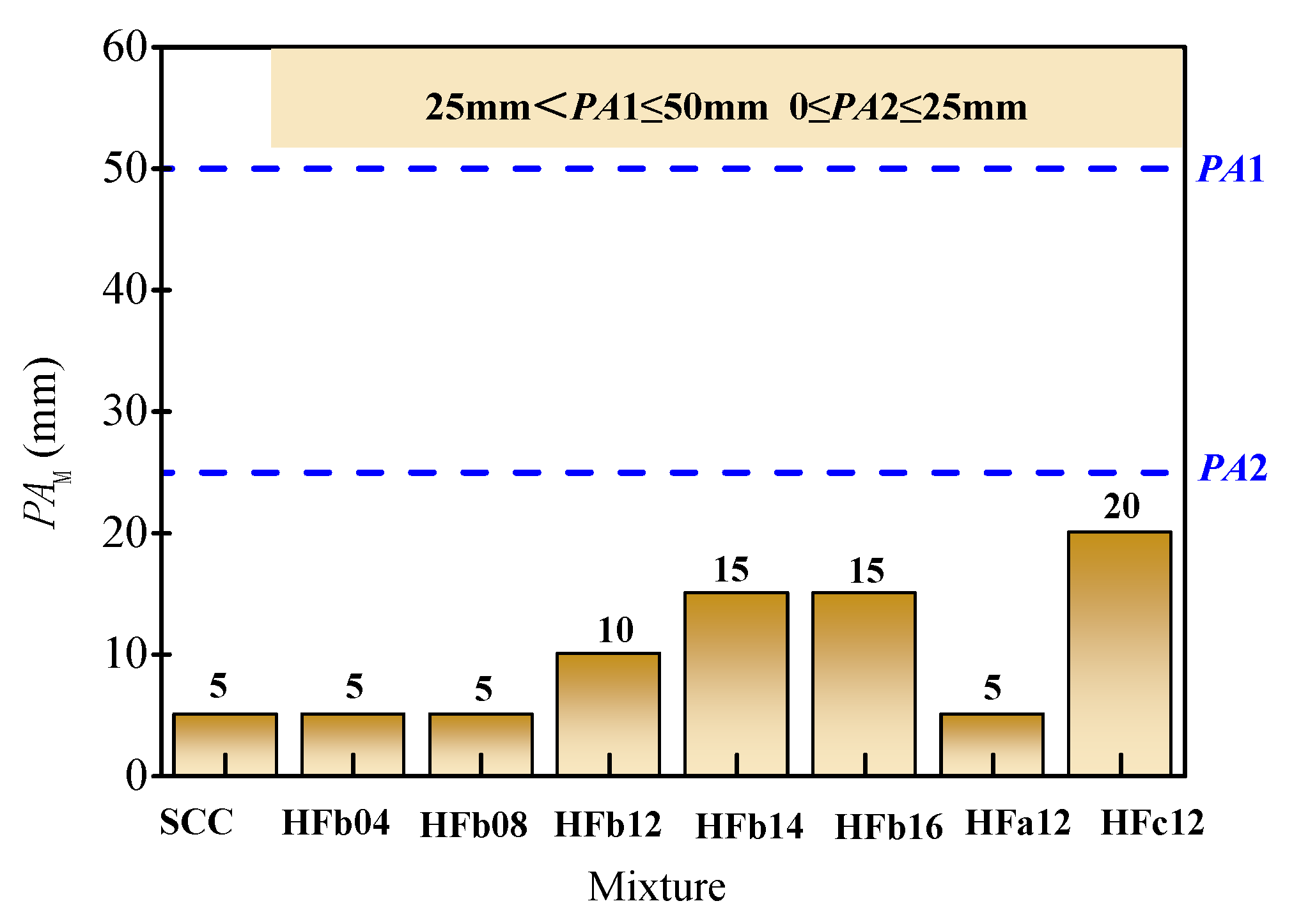
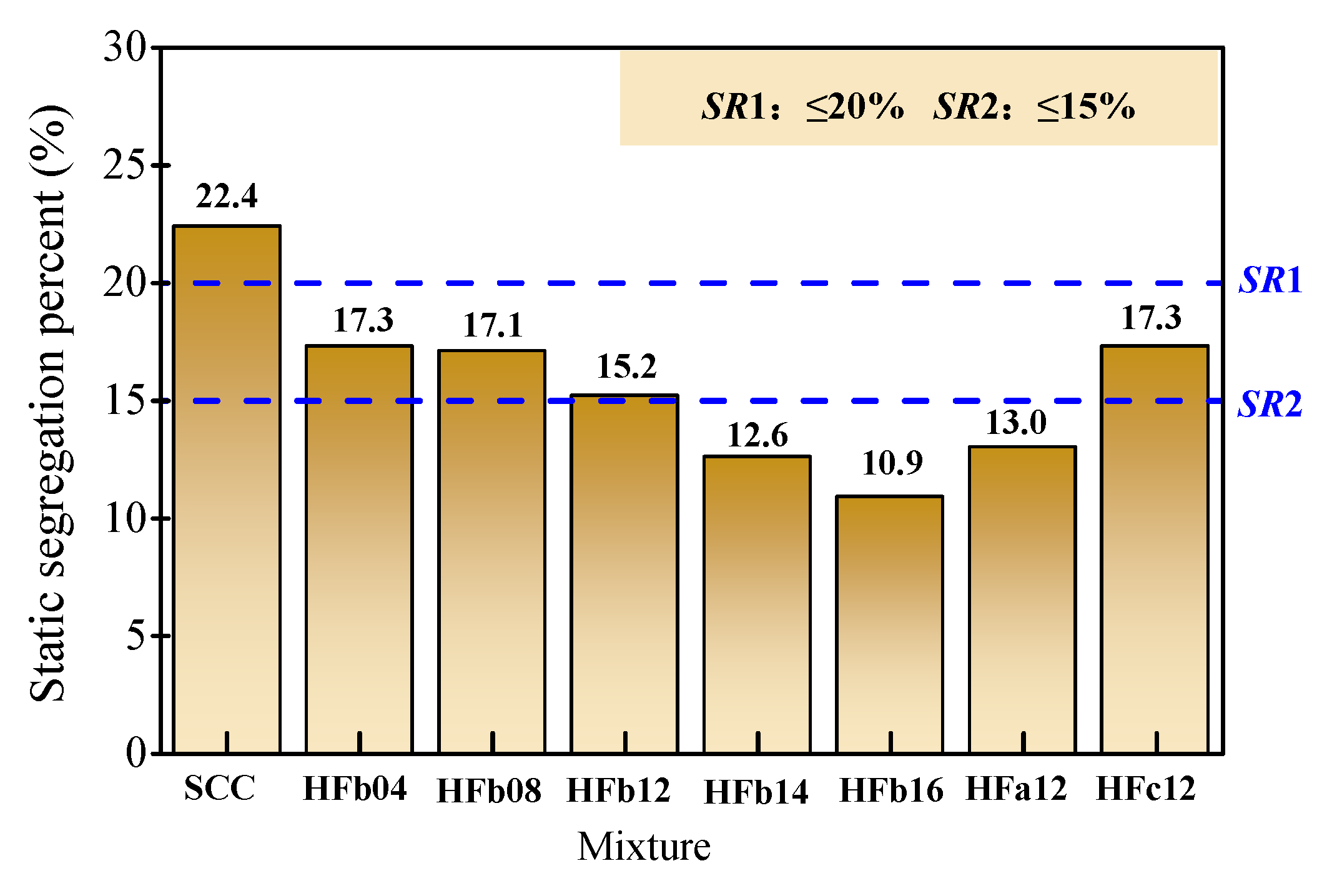
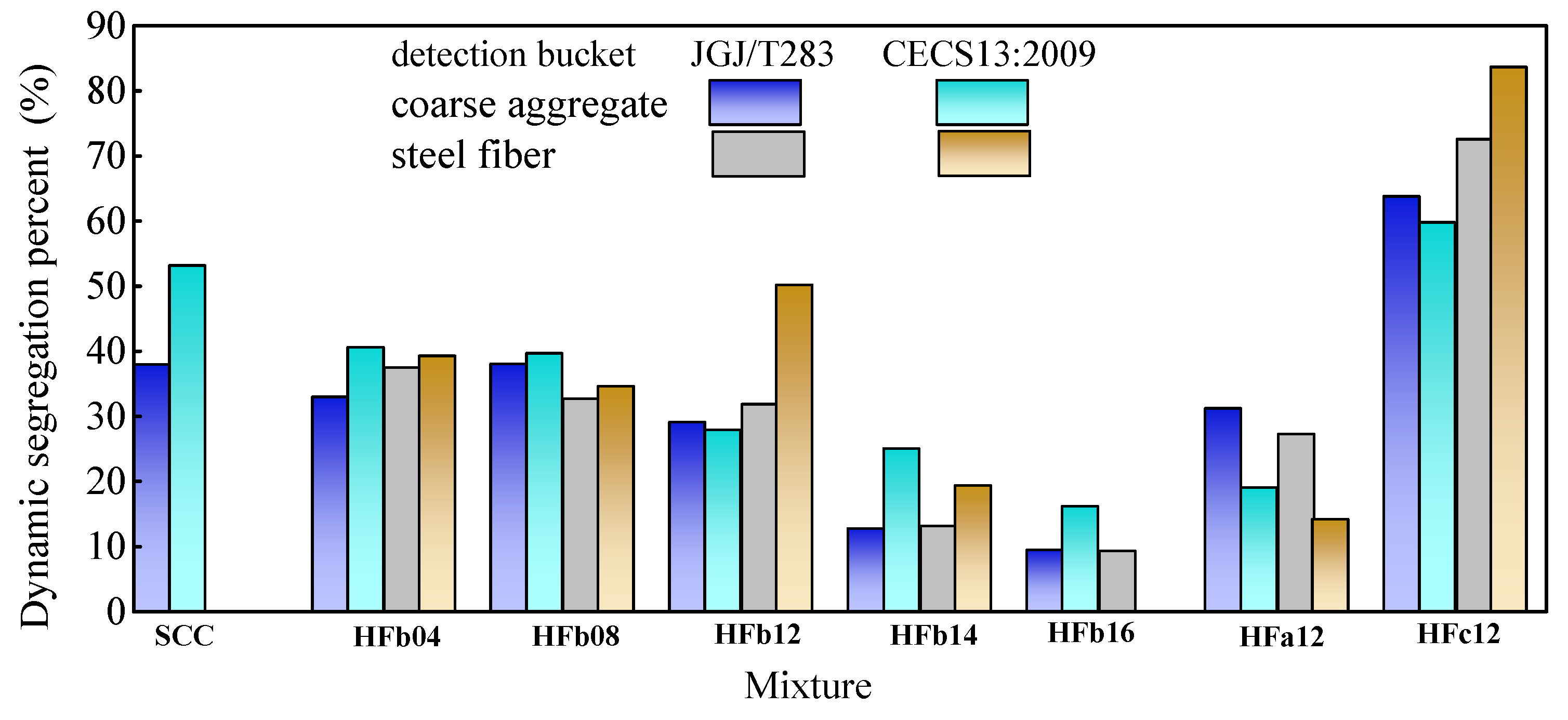
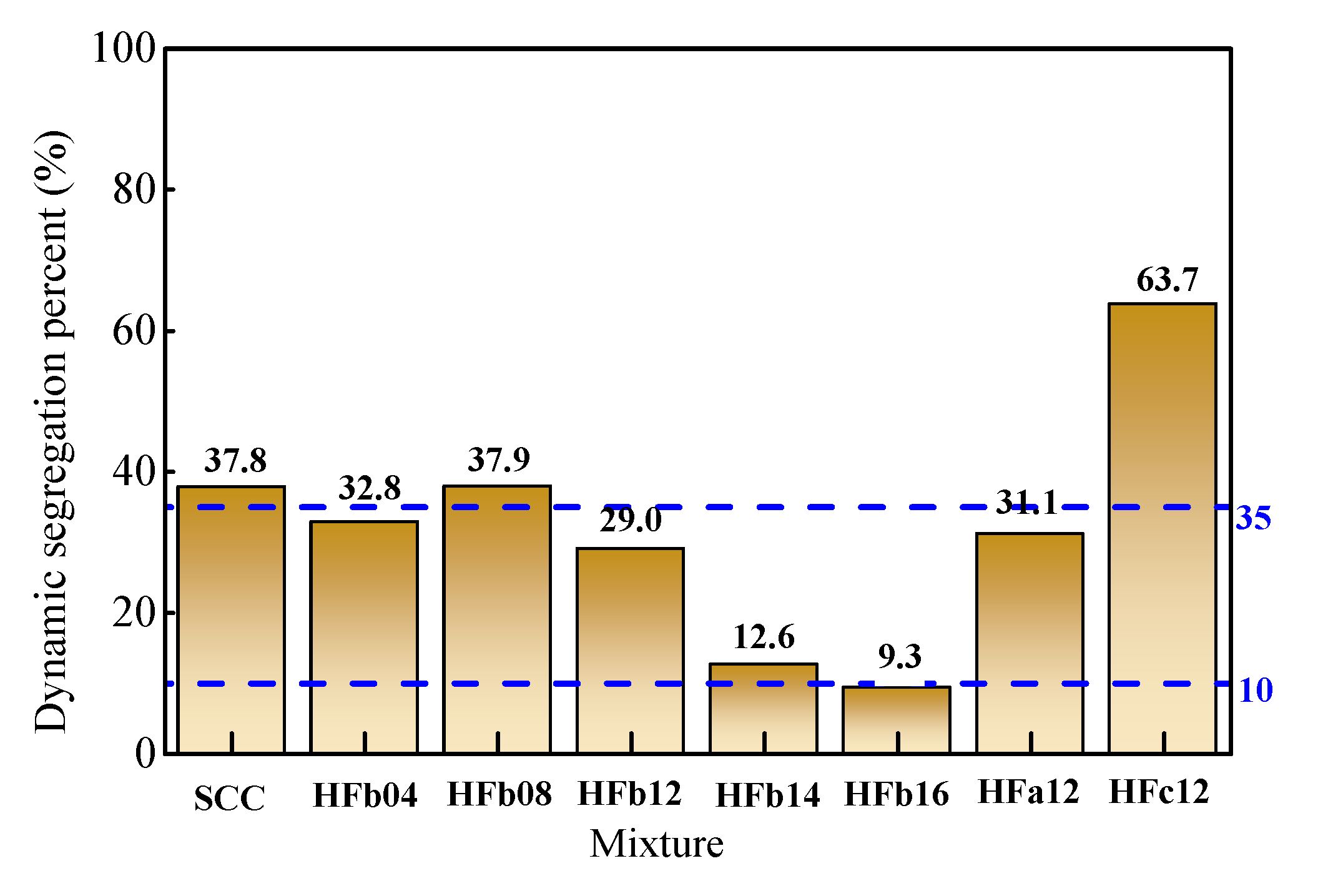
| Fineness (%, 45 μm) | Water Requirement of Normal Consistency (%) | Density (kg/m3) | Setting Time (min) | Compressive Strength (MPa) | Flexural Strength (MPa) | |||
|---|---|---|---|---|---|---|---|---|
| Initial | Final | 3 d | 28 d | 3 d | 28 d | |||
| 8.6 | 26.6 | 3195 | 176 | 222 | 34.9 | 53.8 | 6.23 | 8.83 |
| Name | Apparent Density (kg/m3) | Bulk Density (kg/m3) | Closing Packed Density (kg/m3) | Crush Index (%) | Mud Content (%) | Flat and Needle Particles Content (%) |
|---|---|---|---|---|---|---|
| Manufactured sand | 2740 | 1620 | 1840 | - | - | - |
| Crushed stone | 2735 | 1530 | 1590 | 12.2 | 0.5 | 5.25 |
| Mixture | SCC | HFb04 | HFb08 | HFb12 | HFb14 | HFb16 | HFa12 | HFc12 | |
|---|---|---|---|---|---|---|---|---|---|
| Water to binder ratio w/b | 0.31 | 0.31 | 0.31 | 0.31 | 0.31 | 0.31 | 0.31 | 0.31 | |
| Sand ratio βs (%) | 50 | 52 | 54 | 56 | 57 | 58 | 55 | 57 | |
| Fly ash contnet (%, by mass) | 30 | 30 | 30 | 30 | 30 | 30 | 30 | 30 | |
| Steel fiber | type | - | HFb | HFb | HFb | HFb | HFb | HFa | HFc |
| vf (%) | 0 | 0.4 | 0.8 | 1.2 | 1.4 | 1.6 | 1.2 | 1.2 | |
| Water (kg/m3) | 192 | 201 | 210 | 219 | 223 | 228 | 214 | 223 | |
| Cement (kg/m3) | 433 | 454 | 474 | 494 | 504 | 514 | 484 | 504 | |
| Fly ash (kg/m3) | 186 | 194 | 203 | 214 | 216 | 220 | 207 | 216 | |
| Crushed stone (kg/m3) | 751 | 675 | 601 | 527 | 491 | 455 | 553 | 502 | |
| Manufactured sand (kg/m3) | 751 | 763 | 774 | 783 | 788 | 792 | 784 | 782 | |
| Steel fiber (kg/m3) | 0 | 31.4 | 62.8 | 94.2 | 109.9 | 125.6 | 94.2 | 94.2 | |
| Water-reducer (kg/m3) | 5.57 | 5.51 | 5.42 | 5.30 | 5.40 | 5.51 | 5.19 | 5.40 | |
| Mixture | SCC | HFb04 | HFb08 | HFb12 | HFb14 | HFb16 | HFa12 | HFc12 |
|---|---|---|---|---|---|---|---|---|
| HD (mm) | 0 | 23 | 30 | 26 | 42 | 62 | 25 | 46 |
| HDM (mm) | 0 | 0 | 0 | 6 | 25 | 26 | 21 | 23 |
Publisher’s Note: MDPI stays neutral with regard to jurisdictional claims in published maps and institutional affiliations. |
© 2021 by the authors. Licensee MDPI, Basel, Switzerland. This article is an open access article distributed under the terms and conditions of the Creative Commons Attribution (CC BY) license (https://creativecommons.org/licenses/by/4.0/).
Share and Cite
Ding, X.; Geng, H.; Shi, K.; Song, L.; Li, S.; Liu, G. Study on Adaptability of Test Methods for Workability of Fresh Self-Compacting SFRC. Materials 2021, 14, 5312. https://doi.org/10.3390/ma14185312
Ding X, Geng H, Shi K, Song L, Li S, Liu G. Study on Adaptability of Test Methods for Workability of Fresh Self-Compacting SFRC. Materials. 2021; 14(18):5312. https://doi.org/10.3390/ma14185312
Chicago/Turabian StyleDing, Xinxin, Haibin Geng, Kang Shi, Li Song, Shangyu Li, and Guirong Liu. 2021. "Study on Adaptability of Test Methods for Workability of Fresh Self-Compacting SFRC" Materials 14, no. 18: 5312. https://doi.org/10.3390/ma14185312






